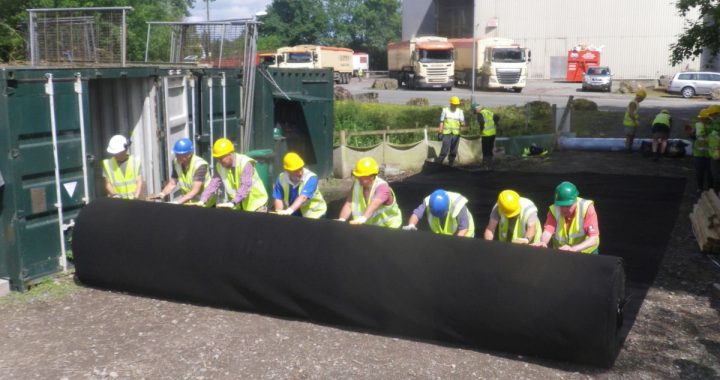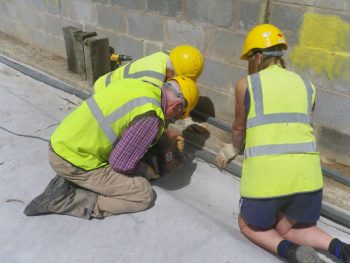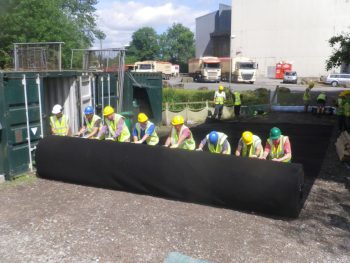This report covers two separate work parties spread over two weekends and eight days. All of the action was on Phase 1A and saw the base of the channel in first 25m from Pryces Bridge lined and concreted, and a substantial section of the channel shaped.
A large turnout of volunteers on Friday made possible simultaneous work on three tasks. The hole in the original section of the Pryces Bridge wing wall which was discovered during the last work party was filled by an extension of the foundation of the adjacent newer wall. This stemmed the flow of water from the wall for all of five minutes, whereupon it emerged elsewhere. The shaping gang got to work on the offside slope and their patient efforts over the three days saw twenty-five metres finished.
It is hard to believe that it is three years since the last liner was laid and thus the remaining Friday task was introducing, or reintroducing, the art of cutting and laying the lining materials to the volunteers. This was necessary because there have been a number of changes to volunteer personnel over this time, and both the liner system, and the method of fixing liner to the vertical surfaces, had changed. The liner system now has four layers (the liner sandwiched between two polythene sheets and covered with geotextile), and the fixings now use plastic batten and some ferocious looking self tapping concrete screws.
Saturday was a day of frantic activity. The lining materials were cut to length in the compound, carried to the channel and unrolled from the top of the towpath slope. The main problem was cutting the geotextile which had been delivered some time ago on enormous 6 metre long rolls. A technique of moving these was devised but it took about ten volunteers to safely cut and transport it. The difficult part of the lining operation was to make sure that the materials were in the right order, the right way up, had the correct overlaps and that the intricate details at the corners were correct. Saturday passed in a blur but at the end the whole of the channel was lined bar a couple of sheets of geotextile and the fixing operation was moving apace.
The main work on Sunday was erecting formwork to contain the mass concrete base. This had to be positioned and fixed at the base of the slope but in such a way as not to penetrate the liner. The method used was to use scaffold boards held in place by long scaffold tubes which were anchored at the top of the towpath slope. The basic structure was relatively easy to construct but several iterations were necessary to get the final positioning correct. A similar system was used across the channel at the end of the retaining wall. By the end of weekend work on the liner, fixings and formwork had been finished according to plan.

Regular readers of these reports will know that ‘the weather’ is a recurring theme. The climatological trauma this time was that between the two weekends a near continuous downpour resulted in a large amount of water in the area to be concreted. Work on the Friday of the second weekend involved pumping out a considerable quantity of water, and final adjustments to the formwork. Eleven hardy souls were in site at the crack of dawn on Saturday (still raining) to go through the well-practiced routine of a pumped concrete pour at Pryces Bridge. Fourteen cubic metres were placed in less than an hour and we all went home to dry out.







